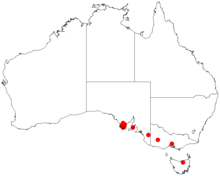Acacia imbricata
| Imbricate wattle | |
|---|---|

| |
| Scientific classification | |
| Kingdom: | Plantae |
| Clade: | Tracheophytes |
| Clade: | Angiosperms |
| Clade: | Eudicots |
| Clade: | Rosids |
| Order: | Fabales |
| Family: | Fabaceae |
| Subfamily: | Caesalpinioideae |
| Clade: | Mimosoid clade |
| Genus: | Acacia |
| Species: | A. imbricata
|
| Binomial name | |
| Acacia imbricata | |

| |
| Occurrence data from AVH | |
Acacia imbricata, commonly known as imbricate wattle, is a shrub species that is endemic to South Australia.
Description
[edit]It grows to between 1 and 2 m (3 ft 3 in and 6 ft 7 in) high and had phyllodes up to 16 mm (0.63 in) long and 2 mm (0.079 in) wide. The yellow globular flowerheads arise from the leaf axils in groups of two or singly.[2]
The shrub has a dense and spreading habit with glabrous branches that appear somewhat willowy. The strongly acutely angled branchlets are ribbed below the phyllodes. Like most species of Acacia it has phyllodes rather than true leaves. The straight and dark green phyllodes are erect and crowded and have a narrowly oblong or linear to oblanceolate shape with an obscure midrib and no lateral nerves.[3]
Taxonomy
[edit]The species was first formally described in 1858 by Victorian Government Botanist Ferdinand von Mueller in Fragmenta Phytographiae Australiae. His description was based on plant material collected from Tumby Bay.[1]
Distribution
[edit]The species has a limited distribution and is located in the south east of the Eyre Peninsula from around the Yeelanna–Ungarra road in the north down to around Koppio and Warunda in the south where it is usually a part of open woodland or forest or scrubland communities growing in sandy soils.[3]
See also
[edit]References
[edit]- ^ a b "Acacia imbricata". Australian Plant Name Index (APNI), IBIS database. Centre for Plant Biodiversity Research, Australian Government, Canberra. Retrieved 2010-09-24.[permanent dead link]
- ^ "Acacia imbricata". Electronic Flora of South Australia Fact Sheet. State Herbarium of South Australia. Retrieved 31 July 2011.
- ^ a b "Acacia imbricata". World Wide Wattle. CSIRO Publishing. Retrieved 15 June 2020.
